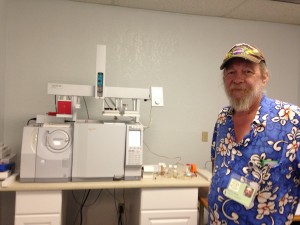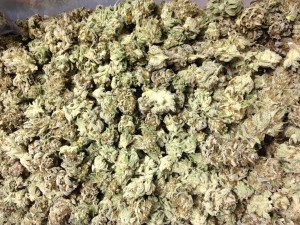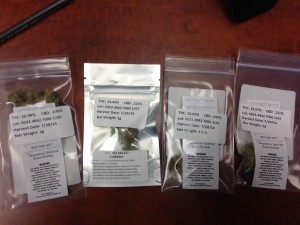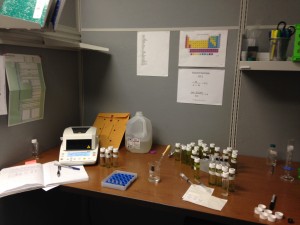More on lab results and random THC counts
Got an email this morning from Muraco Kyashna-tocha of the Green Buddha Patient Coop who had some comments on my story about THC counts being all over the map.
He wanted to point out that some labs on the medical side test for a much wider variety of things than those in the state system.
“I run the state’s oldest medical cannabis collective and we fully test… in fact we also test for pesticides,” he said. “And we/Green Buddha have led the state in raising attention to the need for testing… and to be clear the state is NOT testing for pesticides (we do) and the state has YET TO INSPECT the labs which probably best explains the difference results in the labs.”
Some rec labs have tested strains as high as 33 percent THC, which Kyashna-tocha said isn’t realistic.
“The strongest bud in the country has only been tested by fully inspected labs at maximum 24-25 percent THC,” he said.
While his cooperative does test for more things than labs on the rec side, there are no requirements on the medical side for that sort of testing. So if you’re a patient, it’s probably a good idea to check in and make sure you’re getting a good array of test results about your meds.
As for the rec side, those THC and CBD counts seem like something that will remain hard to pin down.
Attached is the story I did on the subject that ran on Sunday.
Cheers,
-SueVo (sue.vorenberg@columbian.com)
THC counts in marijuana: It’s complicated
In the back room of Main Street Marijuana, Adam Hamide scrunched his eyes, puzzled, as he laid out four bags of pot that were harvested by the same grower on the same day.
Labeling on the packages showed a tetrahydrocannabinol, or THC, content of 20.99 percent, 13.43 percent, 24.66 percent and 19.57 percent on the different bags, even though they all contained the same Blue Dream strain harvested by Liberty Reach on July 28.
“That’s just weird,” Hamide said, leaning over the bags for a closer look.
THC is the active ingredient in marijuana that makes users feel a euphoric high, among other things.
The variation of the drug is due to the sampling process. Growers must submit a test amount, usually about 3 grams, to a certified lab for every 5 pounds of product they sell.
And with THC counts differing from plant to plant, even in the same crop of cloned Blue Dream, a bit of variation is expected.
“I guess it depends on where you pick your sample from,” Hamide said with a shrug.
So does that mean the THC count on the label is actually the count in the bag? The answer’s a bit more complicated than you might think.
“Some people have asked us for the higher-count stuff,” Hamide said. “And other people have asked us why there’s such a difference.”
Dana Luce, owner of GOAT Labs, the only Initiative-502 certified marijuana testing lab in Vancouver, said there’s even more going on than just the variation from plant to plant.

Counts also vary depending on which part of an individual plant the product comes from.
“In an indoor grow, typically speaking, you’re going to have variations from plant to plant, and even one plant by itself, you can have a 3.5 percent variation from top to bottom,” Luce said. “It’s not like you grow a plant and it’s all the same.”
His lab, which he started about five years ago with a focus on medical marijuana testing, got licensed for I-502 recreational growers on July 22. He works with growers on both sides, although so far there aren’t a lot of I-502 growers that are producing material for testing, Luce said.
Under I-502, which legalized recreational marijuana in the state, growers can select which samples they send in to a lab, rather than the lab’s collecting those samples independently. “I tell people, ‘You want a great result, give me the top part of the plant; you want an average, give me the middle,’ ” Luce said. “Guess what part they often give me?”
That said, things are a bit more above-board on the recreational side. In the medical marijuana system, Luce said, he’s heard of growers’ actually bribing labs to give them higher results.
“There are some labs that, if you have an 18 percent and you want a 22 percent, you can pay them $100 and they’ll adjust it for you,” Luce said, shaking his head. “We don’t do that. And actually, it’s not as big a problem in Washington as it is in Oregon, but it still happens.”
A few growers on the medical side have also tried to bribe him, he said with a frown.
“If that happens, we won’t work with them again,” Luce said.
Katey Cooper, who works at Monkey Grass Farms in Wenatchee, said most I-502 growers don’t cherry-pick samples from the top of their plants. At her farm, workers harvest and trim marijuana buds, then cure them in a container where they’re all mixed together.
“We pick out of a large batch that’s all mixed up,” she said. “But we have heard of that happening, especially in the medical arena.”
It is possible that some I-502 growers do select their samples from the tops of their plants, but bribing labs — at least on the recreational side — is unlikely, she said.
“Nobody wants to lose their license,” she said.
Shane Wahl, head grower at Vancouver’s CannaMan Farms, said he also doesn’t cherry-pick samples. The buds he sends for testing are randomly selected out of his bin of mixed up cured product.
“I pull out the whole batch when it’s done and just grab a bunch of small buds usually,” Wahl said. “Anything that looks super-pretty, I want to save that for the customer.”
The pace in the I-502 industry, with rampant shortages throughout the state, leaves little time for cherry-picking, he added.
And as for sample variations, he said he’s tested samples from the top and bottom of his plants, just for his own information — and in a few cases he found buds from the bottom of plants had higher counts than those at the top, which is probably due to where he uses lights on his indoor grow, he said.
“Actually a lot of it also depends on packaging and storage,” Wahl said. “You want to keep the buds at 46 percent humidity, 66 degrees temperature and handle them gently for the best results. But in transport you don’t really know how much that changes.”
Wahl said his counts vary a little, maybe by a percentage point or two per batch, but are generally pretty consistent.
But on the largely unregulated medical side, there are larger problems with testing, or the lack of it, said Wahl, who started out as a medical grower in Oregon.
“The mold screenings and other testing for us (as recreational growers) is hard core,” Wahl said. “On the medical dispensary side, there are no mold screenings, no security for the patient. It’s weird. The priorities are kind of shifted, and that can be dangerous for patients.”



